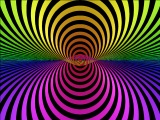
"Math Horizon" is a view of a two-dimensional sphere immersed in four-space so that it has exactly one point of self-intersection. To see how this works, first note that surfaces in four-space generally intersect in points rather than in curves, as they do in three space. For example, if we label the axes x, y, z, and w, then the xy-plane and the zw-plane are two-dimensional planes in four space, but they intersect in only one point: the origin.
To form the sphere depicted in "Math Horizon", we began by taking the unit disc in the xy-plane and the unit disc in the wz-plane; since they intersect in a single point, these form the essential self-intersection in the surface. The trick now is to attach the boundaries of these two discs so as to form a sphere, and in such a way that no additional self intersection is produced.
The boundaries are two circles, which can be parameterized as
(cos ,
sin
, 0, 0)
and (0, 0, cos
,
sin
).
For a given
, these two points, together
with the origin, determine a plane in four-space (think of the points as
vectors based at the origin that span the plane). For different values
of
, these planes intersect only at the
origin, so if, for each
, we connect the
two boundary points by a curve lying in this plane, we will have joined
the two disc boundaries to form a sphere with no additional
self-intersection, as desired.
|
|
| The two points
(cos |
Note that the two points, when considered as vectors at the origin, are perpendicular unit vectors, so they act just like the unit x- and y-axes in the xy-plane. The intersection of the plane spanned by these vectors and one of the discs would be the segment from -1 to 1 along the x-axis, and with the other, the corresponding segment on the y-axis. These two segments form a "cross" at the origin, and one natural way to attach them is by two circular arcs thus forming a figure-8 with an axis of symmetry along the line y = x. A piecewise-defined version of the two-sphere in four-space can be produced in this way. On the other hand, we could form a smooth version of the surface if we had a smooth (rather than piecewise-defined) figure-8.
The equation (cos t, sin 2t) parameterizes a
figure-8 that has the x-axis as an axis of symmetry, though the
equation (cos t, (1/2)sin 2t) = (cos t,
sin t cos t) = cos t (1,
sin t) is more aesthetically pleasing, as the lobes of the
figure-8 are rounder and cross at an angle of 90 degrees. Rotating this
curve by 45 degrees about the origin produces a smooth figure-8 with its
axis along the line y = x and its crossing tangent to the
x and y axes, as desired. Using a standard rotation
matrix with angle =
/4, we obtain
Writing this in vector notation, we find
Now, replacing the vectors (1,0) and (0,1) by the two vectors from
the boundary of the discs in four-space gives a smooth parameterization
by t and of the two-sphere in
four-space with exactly one point of transverse self-intersection:
Note that this surface lies within the unit sphere in four-space and touches the unit sphere when t = 0, namely along the curve